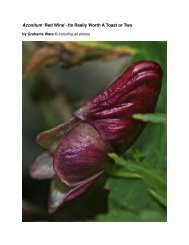Asarina procumbens 'Forma compacta' IRG - Owl and Stump Rare ...
Asarina procumbens 'Forma compacta' IRG - Owl and Stump Rare ...
Asarina procumbens 'Forma compacta' IRG - Owl and Stump Rare ...
Create successful ePaper yourself
Turn your PDF publications into a flip-book with our unique Google optimized e-Paper software.
Christine Grey-Wilson did an absolutely lovely drawing of <strong>Asarina</strong> <strong>procumbens</strong> on p.40<br />
in her husb<strong>and</strong>'s "A Manual of Alpine Plants" (1989, Helm/Timber Press). It looks for all<br />
the world like the forma compacta <strong>and</strong> his description matches it to a T. (MAGGI: Any<br />
way of getting permission from her to use it?) However, it was twenty years later in<br />
2009's "The Rock Garden Plant Primer" (Timber Press), that Chris Grey-Wilson<br />
becomes the first author to give mention of the plant under discussion- the forma<br />
compacta (although Grey-Wilson refers to it on p. 62 of the latter publication as 'nana'. )<br />
I am going to assume that 'nana' <strong>and</strong> 'compact form' are one <strong>and</strong> the same. Anecdotal<br />
evidence of this interchangeability of terms in this specific case is provided by the<br />
eminent Canadian alpine nurseryman, Harvey Wrightman http://<br />
www.wrightmanalpines.com/plant/asarina-<strong>procumbens</strong>-compacta. Mr. Wrightman had<br />
previously used the term 'nana' but now calls it compact form. I believe that it is more<br />
botanically correct to refer to it as 'compact form'.<br />
But what of its origins?<br />
There really is not a lot of hard evidence as to what is the source of the 'compact form'.<br />
The RHS Plantfinder 2011-12 shows plants last listed in 2003. None were listed before<br />
or since accoring to my research. If anyone knows more on this please weigh in on the<br />
Forum. Thus, it would seem that it is a recent arrival on the horticultural scene. Grey-<br />
Wilson's inclusion would seem to support this idea. The Alpine Garden Society seedex<br />
listed the compact form in 2004/2005 as lot # 1556. I do not have access to previous<br />
years seed lists so that's as far as I can go. Similarly, it seems that last year was the first<br />
time it had been listed on the SRGC seedex. Lucky me!<br />
According to many Spanish, ecologically-partial websites (academic), A. <strong>procumbens</strong><br />
loves subalpine, moist climates growing primarily in rock ledges that are largely<br />
siliceous in minerals i.e. schist, granite, gneiss. It can grow at elevations up to 2400m in<br />
the eastern Pyrenees Mtns. With this kind of range both across the Pyrenees <strong>and</strong> at<br />
fairly high altitudes, it seems possible that someone may have found a 'compact form' in<br />
their travels through the mountains <strong>and</strong> quietly put it into horticultual 'play'. It has also<br />
been a horticultural feature in many French Pyrenean villages for hundreds of years.<br />
Possibly a sport emerged there as well. It is all speculation at this point.<br />
Nomenclature<br />
The most commonly used recent synonym is Antirrhinum asarina. Previous to this it has<br />
been called Antirrhinum <strong>procumbens</strong> <strong>and</strong> Maur<strong>and</strong>ya asarina with earlier authors calling<br />
it Antirrhinum saxatile (Bauhin), <strong>Asarina</strong> mathioli (Mathioli), <strong>and</strong> Hedera saxatilis<br />
(L'Obel).



